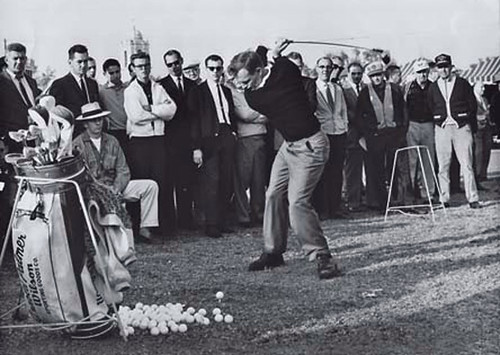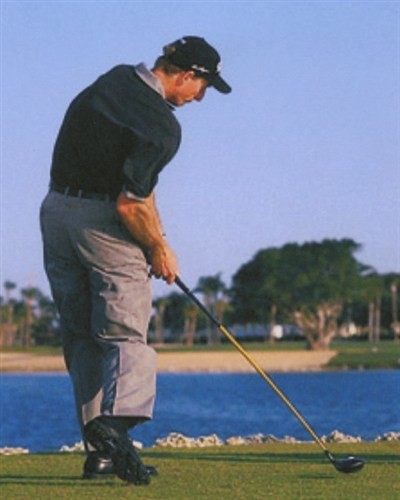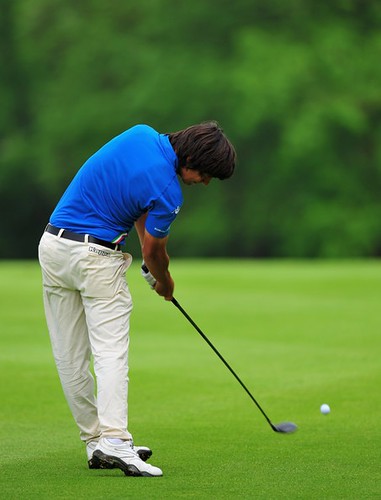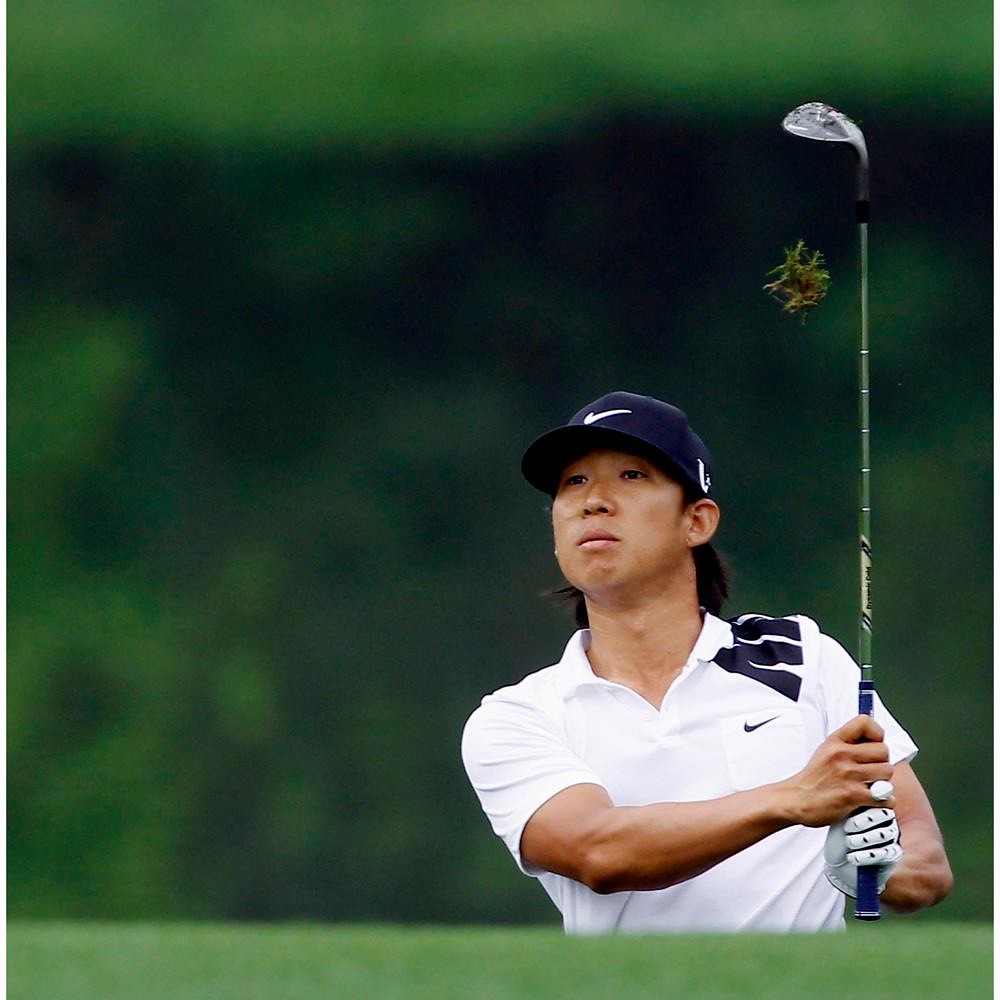A swing mistake that has caused me grief (left over from my S&T days) is straightening my right leg too much on the backswing. I had an outing once in Panama City, FL where I focused on keeping the right knee bend established at address into the backswing, and I had very good results throughout the round--fewer mishits and even more distance. As with anything in golf, inattention to one part of the swing can allow old habits to return.
 |
| Note Palmer's Right Knee and Level Hips |
I never completely straighten it now, but I occasionally (unconsciously) do it enough that it is changing the angle of my pelvis, which tilts the body left and causes a slight, unintentional reverse weight shift to the left. This requires a compensation on the way down which can lead to toe shots and other mishits. Obviously, straightening the right leg is desirable in S&T but not in a conventional swing.
To fight this, I like to feel like I'm sitting down (into my right hip) when I turn (see Paul Wilson's video below); in a way, it feels like I'm bending the knee more, when I'm actually just maintaining very close to the same bend I had at address (because I've been used to straightening it excessively). When performed correctly, the right hip moves straight back (not up or to the right) and feels very loaded and the pelvis feels very level--just turning, not tilting. The lower body feels very coiled, ready to unwind in its own flat plane, and capable of producing tremendous torque once you let it go. You will find no end of material on the internet that addresses this subject: keeping the bend in that right knee all the way through is important.
Properly executed, you can feel an unmanufactured, correct weight shift forward into the ball, where the weight goes from inside the right foot, first into the left big toe, and then around the outside of the left foot and into the left heel, just as many great golf instructors (like Hank Haney and David Leadbetter) teach.
This is one of those areas of golf instruction where there is debate among reputable teachers and professionals; new, popular swing methods require a straight or straighter right leg on the backswing. Examples of old golfing experts like Bobby Jones completely straightening the right leg on the backswing are used as proof for the validity of straightening the right leg. However, watching the video of Jones from behind, you'll notice that he regains the original address flex of his right leg during the downswing, well before impact. Many amateurs like me fail to execute this compensation, and instead, we straighten the left leg too much coming down to level the pelvis and end up catching the ball fat and thin; in essence, we're unitentionally "standing up" at impact. One avoids having to regain the right knee flex of the address position if one simply keeps the original bend--or close to it--in the right knee into the backswing; it is eliminating the need for a compensation.
There are, of course, a few words of caution. First, be wary of swaying. The right hip can feel loaded but still exhibit a sway, where the right hip moves rightward (away from the target) of its address position; if the right hip sways, the left shoulder will often tip towards the target. The right hip should move backwards while staying close to the same level during the backswing, never towards, over, or outside the right foot. The correct address position should form a "reverse K," meaning the right leg should be slanted away from the target at an angle that makes the entire address position of the body look like an inverse K.
A simple check: After address, place the club down the middle of your chest mimicking the spine without moving. If you are in the proper Reverse K position, the handle of the club will touch the inside of your left thigh. The position of the sternum should be behind the pelvis at address and all points during a standard full swing.
The right leg should really never move from this angle from the front-on view during the backswing; the right hip moves back ONLY (not up, down, or sideways). From the golfer's perspective, just focus on keeping the right hip inside the instep of the right foot at all times. The right leg braces against a firm left side, as Shawn Clement teaches. Your right leg, from your perspective looking down, should be angled outward to the right or away from the target--it shouldn't lose that angle while the right knee stays bent in the backswing.
Next, watch out for the tendency of the head to drop too much. The head SHOULD drop some on the backswing when correctly loading into the right leg; according to Jim McClean (video below), 70% of tour players drop their heads in the backswing some. Some professionals have so much lag that they drop even more on the downswing. Too much of a drop can happen if you're overzealous with focusing on keeping the bend of the right knee. You may unintentionally bend it more and drop the upper body too much into the right hip. This squat feeling definitely loads for power and torque but increases the chances of hitting fat behind the ball without enough compensatory action in the downswing. Be especially careful when hitting the driver; it's better to keep a very steady and somewhat level head when using longer clubs. Will the head move? Yes. But steady is better with the driver for most amateurs. Just be wary of going to far; anything in golf can be taken too far.
If you rotate properly into your right hip, your hips should remain level, allowing you to make a downswing that is on plane, and compresses the golf ball.If you’re like me, you may slide off the ball during the takeaway, then your right hip gets higher than your left at the top of your swing, causing you to come up, and back out of the shot to even make contact with the ball. If you hit thin shots, off the toe, you may be making this mistake.
[From Correct Hip Movement In The Golf Swing]
Although a full shoulder turn is vital to a powerful golf swing, be sure not to compromise one key fundamental: right knee flex (for right-handed golfers).The role of the right knee in the backswing is very simple, but incredibly important. The importance of the flex in the right knee is undeniable. The flex in the right knee helps keep the hips more level in the backswing. If the right knee straightens, it pushes the right hip up and consequently the left hip down resulting in too much left-hip tilt in the backswing.***Another key reason to keep the right knee flexed is how it is used in your transition into your downswing. Your right knee is a key source of driving power of your lower body in the downswing. It's very difficult to drive off a straightened right leg in the transition. Therefore, the upper body tends to dominate the downswing resulting in poor swing plane and loss of power.
[From Looking for a way to make your golf swing more repeatable? Remember knee flex]
There are many important facets to a good golf swing, but maintaining the bend in the right knee is one that simply can’t be overlooked. When a student comes to me with a common complaint (slicing, poor ballstriking or a general lack of consistency), I always take a close look at his or her body angles, and make certain that their posture and knee position are constant throughout the swing.
[From Golf Tips - Maintain The Bend]
Here is another great swing thought - and one that is inter-related with that idea of turning the Right Pocket Back. Maintaining a level belt line as you turn your shoulders and upper body allows your weight to go fully on o the right heel, which gives you more time to fully wind and unwind your swing for maximum clubhead speed.There's nothing worse than seeing a golfer with a short, quick swing which chops down on the ball. And the last thing you want is a tilted belt line, like this above, where the right hip/right pocket is very high and the weight hangs on the left side.
[From What the pros do - Robert Baker]
Other tips to increase power in your golf swing: Flex the back knee during the backswing: Keeping your back knee flexed during the backswing does two things. First, it restricts your hip turn so you can coil your upper body (the upper body continues to turn against your hips), this builds energy in the backswing. Next, it allows you to drive your weight off your back foot during the down swing so you can release the club head through the impact area.
[From Golf tip: Remember, in your backswing, width equals power - GolfInstruction.com]
If you’ve been struggling with consistency, and you find yourself hitting thin, fat, and even topped golf shots, I want you to pay attention to what your right knee is doing in your backswing.Many times a golfer will either straighten the right knee in the backswing, or let it move to the side (away from the target), which results in a sway off the ball. This may seem like a minor issued in your swing, but let me tell you from firsthand experience, it WILL cause many faults in your swing unless you fix it right now!
The Role Of The Right Knee In Your Backswing
If and when the right knee flex is lost, as is the case with so many amateur swings, weight is thrown from the right side back to the left (reverse pivot). That’s a big no-no. Second, straightening the knee moves the backswing plane to the inside, which can lead to all kinds of downswing misery. Third, losing the right knee flex gives your lower body too much room to turn, in addition to allowing it to sway away from the ball on the backswing. As a result, you lose all of your coil. Potential energy is nil, and all you’re left with power-wise is what you can generate by moving your arms as fast as you can back down to the ball. It’s an unleveraged motion that’s both weak and inconsistent and certainly no part of a successful swing.As far as maintaining flex, I advise my students to preset a solid, bent right knee. This preset goes beyond simply flexing the knee and holding it there. At address, and without lifting your right foot, bend in your right knee slightly, like you’re trying to point your kneecap at the golf ball. It’s just a slight kick in to the right.
The Key Ingredient | GolfTipsMag.com
All-time golf great Jack Nicklaus believes a player’s knee action is important to a proper backswing. As you take the club back the front knee should move forward and to the right (for a right-handed player) to allow your hips to rotate properly. At the same time, the back knee should remain stiff to brace the right leg and prevent your body from sliding to the right. When your back leg remains firm during the backswing, "the body is coiling like a spring around the knee," Nicklaus says.Tiger Woods says if you slide your right hip outside of your right foot "you’ve cut your power by about 50 percent." Woods focuses on keeping his weight over the inside of his right foot during his backswing while keeping the angle of his right leg steady.
Coiling In the Backswing | Golfsmith
The key to achieving this effortless backswing is keeping the spine angle you establish at address a constant. The spine angle and right-knee bend are closely related, and it’s necessary to maintain both angles for a solid golf swing.
Maintain The Bend | GolfTipsMag.com
The way you will know that you start the backswing properly in the lower body is that there will be tension in between your right thigh and right hip flexor.
Golf Lessons 101: Knee Action Basics | Golf Lessons 101
Recently, I was working with a student (we will call him Allen) on this very move and I noticed that his rear leg was straightening in his backswing. I have seen this before in golfers and this error can cause a number of swing errors like reverse pivoting, or can cause you to top the ball or hit it thin. Often I will try to create a swing error with my own body to help me to feel what the student is feeling which allows me to explain why a particular problem is occurring. As I made a backswing and straightened my right leg, as my student did, I noticed that I had no way of pushing off my back side to move my hips through. Allen had no way of rotating his left hip backwards because he couldn’t push-off his right side.
The Right Knee and my Upcoming Article | Guru's Golf Blog
Most players never load their butt muscles during the swing properly. In fact, many golfers straighten or lock the right knee completely before they even finish their backswing. If you straighten up during this phase, it causes an "over the top" move so common to amateurs and saps all the power from the trunk or core muscles. Ideally, you should maintain a slight knee flex at the top of your golf swing or think of maintaining the same knee flex that you started with at the address posture. This should feel like a semi squat.
Unlock Your Power


